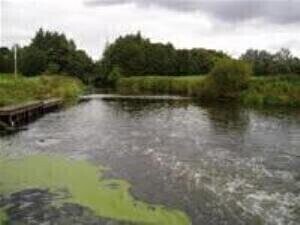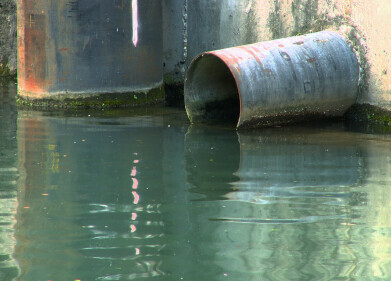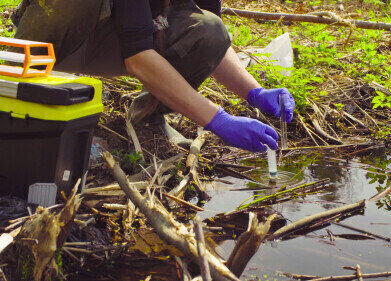Water Pollution Monitoring
New water pollution monitoring system to make waves in the environmental monitoring sector
Jun 05 2023
A ground-breaking water pollution monitoring system, featuring a low-cost, 3D-printed sensor, is about to change how many in the water sector will go about their environmental monitoring tasks, according to its developers.
A collaborative team of researchers from highly respected universities in Scotland, Portugal, and Germany have successfully engineered a sensor capable of detecting minute concentrations of pesticides in water samples. Their ground-breaking work, which has been detailed in a paper titled "Additive manufacturing-enabled architected nanocomposite lattices coated with plasmonic nanoparticles for water pollutants detection" and published in the journal 'Macromolecular Materials and Engineering,' is set to streamline water monitoring processes, making them more efficient and economical.
Pesticides have a vital role in safeguarding agricultural produce. However, because of their potential to harm human health, animals, and the environment, extremely safe handling is necessary. To mitigate water pollution risks associated with pesticides, regular monitoring and analysis is of huge importance. Currently, pesticide tests predominantly take place in laboratories, using methods such as chromatography and mass spectrometry.
Although these established tests provide precise and dependable results, they are both time-consuming and expensive. An up-and-coming alternative which is gaining traction in the scientific community, is Surface-Enhanced Raman Scattering (SERS), a chemical analysis tool. SERS leverages the distinctive frequency variations observed when light interacts with different molecular structures. By analysing the unique "fingerprint" created by the scattered light, scientists can identify and detect trace amounts of molecules present in test samples adsorbed on a metal surface.
The efficacy of SERS can be enhanced by optimising the metal surface to promote better adsorption of molecules, thereby increasing the sensors' ability to detect minuscule concentrations of these substances in samples.
This project was motivated by the demand for a portable and cost-effective testing method that provides prompt and precise on-site results. The research team focused on developing a novel approach; they aimed to utilise affordable 3D-printed materials capable of adsorbing molecules from water samples and delivering accurate preliminary results in the field.
To achieve this, the researchers explored various cellular architectures composed of mixtures of polypropylene and multi-walled carbon nanotubes. These architectures were fabricated using fused filament fabrication, a ubiquitous 3D printing technique. The surface of the cellular architectures was coated with silver and gold nanoparticles using a conventional wet chemical method, facilitating the surface-enhanced Raman scattering process.
The team then evaluated the performance of different 3D-printed cellular materials' architected designs in terms of their ability to adsorb molecules of methylene blue, an organic dye. Subsequently, the samples were analysed using a portable Raman spectrometer. The most promising material arising from these initial tests was a lattice design combined with silver nanoparticles. This material was incorporated into test strips, onto which water samples spiked with low concentrations of the real pesticides thiram and paraquat were applied for SERS analysis.
The water samples were taken from an estuary in Aveiro, Portugal, and taps in the same area, from locations prone to routine real-world water pollution monitoring tests.
The researchers discovered that the test strips were capable of detecting molecules of both pesticides at concentrations as low as 1 micromolar, which is equivalent to one molecule of pesticide per one million molecules of water.
Professor Shanmugam Kumar, from the University of Glasgow's James Watt School of Engineering and a corresponding author of the paper, lauded SERS as a valuable diagnostic technique applicable across various fields. He emphasised the sensor substrate material's optimal combination of the nanocarbon-engineered architected lattice's expansive surface area and the metallic nanoparticles' remarkable optical properties.
According to Professor Kumar, "The interaction of the strong local electromagnetic field in the metallic nanoparticles and the carbonaceous material's chemical mechanisms creates a highly active surface for SERS analysis. The results of this initial study are very encouraging, showing that these low-cost materials can be used to produce sensors for SERS detection of pesticides even at very low concentrations.”
Dr Sara Fateixa, of the University of Aveiro’s CICECO Aveiro Institute of Materials, who was the paper’s co-author and designer of the plasmonic nanoparticles which enables the SERS technique stated “While this paper examines the potential of the system to detect specific types of water pollutants, the technique could easily be adapted to monitor the presence of a wide range of chemicals in samples. In farming, for example, the milk from cattle, who are recovering from an illness, which was treated with antibiotics can’t be sold until after the drug has left their systems. Currently, the tests which prove their milk is ready to go back on the market are expensive, but our diagnostic materials could be tuned to provide reliable results much more affordably. “
Digital Edition
IET 34.2 March 2024
April 2024
Gas Detection - Biogas batch fermentation system for laboratory use with automatic gas analysis in real time Water/Wastewater - Upcycling sensors for sustainable nature management - Prist...
View all digital editions
Events
Apr 30 2024 Melbourne, Australia
Apr 30 2024 Birmingham, UK
May 03 2024 Seoul, South Korea
May 05 2024 Seville, Spain
May 06 2024 Minneapolis, MN, USA


















